Flight modifications as a response to traffic by night-roosting egrets crossing a road bridge in Hong Kong
Abstract
Few studies have been conducted on the effects of the level of vehicular traffic on the flight behaviour of herons and egrets (Ardeidae) over road bridges, especially when returning to night communal roosts. Individuals and flocks of egrets returning to roost were surveyed twice per month for a 12-month period, between January and December 2009 in Hong Kong. The objectives of this study were to investigate the levels of traffic that may cause disruption to flight paths and any impacts to roosting birds. As they passed over the road bridge, the height of flight and behaviour of flocks and individuals were recorded, along with level of traffic. This study showed that the height of passage above the bridge and tendency for modified flight behaviours were influenced positively by the level of traffic and time of day. While moderate to high levels of traffic appeared to affect their flight and approach (e.g. erratic or interrupted flight behaviour), birds would still proceed to the roost. Birds appeared behaviourally adaptable to traffic and to avoid collisions with either vehicles or the bridge structure itself. No records of collision or collision mortality, from direct contact with the bridge or vehicular traffic, were recorded from this study.
Key words: egrets; erratic flight; flight behaviour; flight modifications; night roost; road bridge; traffic.
Introduction
Bird mortality through collisions with static anthropogenic objects, particularly at night (Evans Ogden 2002, Erickson et al. 2005, Gauthreaux Jr. and Belser 2006, Gehring et al. 2009, Martin 2011), and vehicles (Finnis 1960, Pons 2000, Erickson et al. 2005, Jacobson 2005) is well-documented. Avian mortality with man-made structures is largely a result of collisions with communications towers, high tension lines, wind turbines and buildings (Arup 2002, Erickson et al. 2005). Information regarding mortality as a result of direct collisions with bridges is sparse. During a review of over 1,500 abstracts or summaries of published reports on bird mortality in relation to man-made structures, there were no publications documenting bird collisions with, or bird mortality due to, collisions with bridges or bridge stays (Arup 2002, Parsons Brinckerhoff 2011). Bird deaths associated with bridges are usually a result of the power lines strung across bridges (Weston 1966, Podolsky 1998, Arup 2002, Parsons Brinckerhoff 2011) or during periods of inclement weather when birds are affected by the bridge lighting (Nilsson and Green 2011) or after individuals are downed during strong winds (Owens and James 1991, Jacobson 2005).
In Hong Kong, numerous flightline studies have been conducted and these are usually associated with movements between egret colonies and foraging habitats or flight corridor use by large waterbirds over proposed developments (e.g. Wong et al. 1999, 2001, Kwok and Dahmer 2002, Anon 2005, 2009, Arup 2013) and less so with avian collisions or mortality. The only study of flight behaviour of egrets over vehicular bridges in the region (Arup 2002) was not associated with birds returning to roost. Likewise, there is a paucity of information on egret night roosts and roosting behaviour for the region (Stanton 2011).
Arup (2002) studied flight behaviour and altitude over three vehicle bridges in Hong Kong and one in Macau. All birds species were recorded and the height above the road surface was estimated for those flying over the bridge. While available details on methodology and results were limited, conclusions revealed that more birds flew over the bridges in the evening, and below the bridges during midday and that no flying bird was observed after 30 minutes past sunset (Arup 2002). Furthermore, all birds reacted to bridge structures by changing altitude and all reacted to vehicles on bridges by changing flight direction or altitude (Arup 2002).
Large numbers of egrets flying over a busy road bridge in southern Hong Kong attracted attention as they returned to their roost in late 2008. Flocks of up to 100 birds were seen flying at low altitude over the bridge at dusk, which appeared to coincide with the evening peak hours of traffic. These flocks often appeared to narrowly miss oncoming traffic and displayed erratic flight patterns on occasions. Given the low clearance of individuals and flocks of egrets when passing over the bridge and the potential for collisions with the heavy traffic, further observations were made to investigate the flight behaviour of these birds when coming into roost.
The objectives of this study were to investigate the levels of traffic that may cause disruption to flight paths and any impacts to roosting birds. We tested the hypotheses that an increase in traffic, and size of vehicle, resulted in an increase in flight disruption, and that an increase in flock size also resulted in the higher likelihood of flight disruption.
Methods
Study Area
The night roost was located in southern Hong Kong [22° 14′ 49″ N, 114° 09′ 50″ E], People’s Republic of China (Fig. 1). Roosting birds occupied a group of mature trees, primarily Red-stem Fig (Ficus variegata), along the southern bank of a channelised watercourse (nullah). The roost was in a sheltered location, away from human activity and prevailing offshore wind (Fig. 2). The 25 m wide nullah follows in an east-west alignment, with the western mouth opening into Aberdeen Harbour which acts as a typhoon shelter for the fishing fleet. A road bridge stands over at the confluence of the nullah and the harbour, approximately 280 m to the west of the roost location. Birds fly over this bridge and down a narrow flight corridor, bounded by tall buildings and a wooded hillside, of approximately 40 m in width (Fig. 3).



The 21.8 m wide road bridge has a four-lane carriageway and links the island of Ap Lei Chau to Hong Kong Island. The road surface of the bridge is approximately 14 m above sea level where the bridge crosses the nullah (C. Lee, pers. comm.); this corresponds to a clearance of 12 m between the water’s surface and the bottom of the bridge (Fig. 4). A 1.5 m high central barrier, separating the northbound and southbound carriageways, contains 10 m high streetlighting at approximately 20 m intervals (Fig. 5).


Species known to utilise the roost at different times of the year include Grey Heron (Ardea cinerea), Great Egret (Ardea alba), Little Egret (Egretta garzetta), Cattle Egret (Bubulcus ibis) and Chinese Pond Heron (Ardeola bacchus); Black-crowned Night-Heron (Nycticorax nycticorax) is known to occur locally, though does not roost in this location (Stanton 2011). Little Egrets (Fig. 6) occur throughout the year and are the most abundant species at this location (Stanton 2011). The site is solely utilised as a night roost and for occasional daytime loafing; no breeding of any ardeid species has been recorded from this site. The breeding season for these species in Hong Kong is April to July (Anon. 2016). The night roost is highly seasonal with greatest numbers in late autumn and through the winter months (i.e. late November to February, Fig. 7). There is strong evidence for this roost site to be important for passage birds particularly in the spring (April and May) (Stanton 2011).
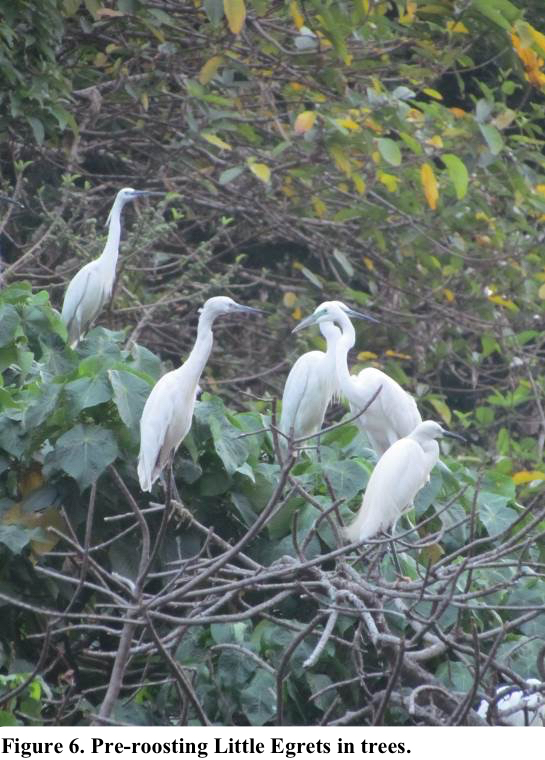
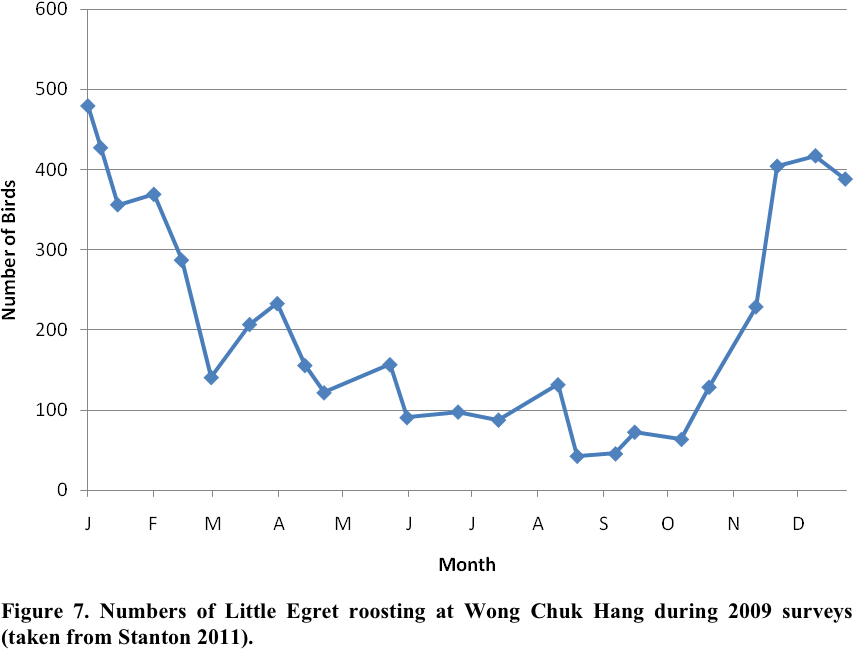
Data Collection
Egrets were surveyed twice per month, on average every 15 days, as they flew toward the roost, for a 12-month period, from January to December 2009, a total of 24 survey dates. Surveys commenced at least 30 minutes before sunset and continued for 30 minutes after sunset, or until such a time that no birds had been recorded for a 10-minute period, or that ambient light was not sufficient to continue. Sunset times were obtained from the Hong Kong Observatory (http://www.hko.gov.hk/contente.htm). The same single observer at a vantage point, situated on the bridge, was used throughout the study. Binoculars were used when necessary to confirm numbers and identification of egrets to species. Parameters recorded included the time of birds arriving at the bridge, the numbers and species going to roost, the level of traffic using the bridge (see below) at the point birds were crossing and any behavioural changes to flight pattern and approach. It was considered that a flight was interrupted when an indvidual or flock of birds changed their pattern of approach to, or flight over, the bridge as a result of traffic using the bridge. The height of passage over the bridge was also estimated using streetlights as a rough guide for height (low = c. 3-8 m of road’s surface; middle = 8-12 m; high = >12 m) (see Fig. 8). Levels of traffic were ranked based on the vehicle usage of the four-lane carriageway (i.e. 0 indicates no traffic on either carriageway; 1 = cars on single carriageway; 2 = cars on both carriageways; 3 = bus or truck on single carriageway; 4 = bus or truck on both carriageways).
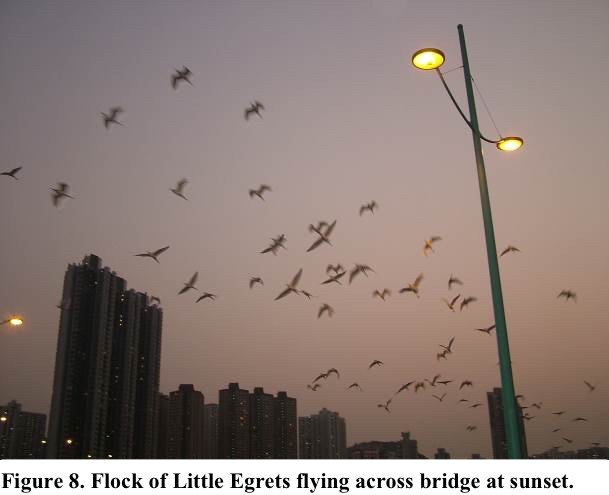
Data Analysis
Due to their numerical superiority, statistical analysis was performed only on Little Egret flocks. Logistic regressions were performed in R version 3.1.0 to model the probability of flocks displaying flight modifications or erratic movements as they passed over the bridge as opposed to those not showing any flight modifications as they passed over the bridge and also flying high over the bridge vs flying low or mid-level over the bridge, based on a series of explanatory (predictor) variables. Specifically, predictor variables included in the logistic regression model were flock size, elapsed time before or after sunset and month. The number of individuals in a flock was grouped by <6, 6-10, 11-20 and >20.
Results
From 964 crossing events, a total of 4,616 egrets was recorded, as both indivduals and in flocks, flying over the bridge during the 24 surveys. There was an average of 40 crossings per survey and the range was 26-88 per survey. The most frequently recorded species was Little Egret (4,420 records of both individuals and birds in flocks), comprising 95.75% of all records. Other ardeid species recorded were Great Egret (187), Grey Heron (5), Cattle Egret (3) and Chinese Pond Heron (1).
Single birds passing over the bridge were recorded on 452 occasions (46.9%). The remaining 512 crossings were of groups of birds passing over ranging between 2-136 individuals (mean 7.79 ± 12.21), with largely single species flocks. There were mixed flocks on 21 occasions (4.1% of flocks), composed of a varying numbers of Cattle, Great and Little egrets; mixed flock sizes ranged between 3-89 birds.
The majority of birds passed over the road bridge on their approach to the night roost, as opposed to flying underneath the bridge. No collisions of egrets with traffic were observed during the study. There are no historical reports of bird collisions at this site (C. Lee, pers. comm.). Across the study, 23 observations were made of single birds (all Little Egrets) passing underneath the bridge; none were in flocks. Little Egrets were recorded throughout the year and no nesting activities were recorded.
As flocks entered the western entrance of Aberdeen harbour, they flew low, within 2 m, of the sea’s surface. Egrets tend to fly low over the sea (BMT Asia Pacific 2009, ERM 2009) and this was apparent during this study as flocks could be seen flying low between moored fishing boats in the harbour on their approach. Flocks took the form of irregular shaped, massed groups, not as an inverted ‘V’ shape as typically seen on migration. Within these flocks, individual birds flew with retracted necks and legs stretched backwards along the body. When approximately 300 m (west) of the bridge, the flock would begin to gain altitude in order to fly over the structure. On occasions, birds would display erratic flight behaviour as they approached or crossed over the bridge, usually as result of increased presence of traffic. This erratic flight behaviour and modification would take the form of a combination of neck extensions and flaring horizontally right or left with outstrected wings and dangling legs. More extreme cases would involve birds flaring both horizontally and vertically and would wheel away from the bridge for a short distance (up to 50 m), either individually or collectively, and loop back around to cross the bridge a few seconds later when traffic patterns had changed. This flight behaviour fits a similar description of “side slipping swerving flight”, used by Blaker (1968) and Voisin (1991) to describe Cattle Egret and Little Egrets using a particular form of flight to loose height rapidly. Once safely over the bridge, birds would then continue at a similar height along the nullah towards the pre-roost trees. Flocks would usually fly beyond the pre-roost (up to 100 m beyond) before turning back and dropping into the trees often with a rapid descent, almost as if parachuting down. On some occasions, usually with larger flocks in lower light levels, several approachs and turns would be made before finally descending into the pre-roost trees. Birds generally arrived within the 15-minute period before and after local sunset; peak arrival of birds was in the range of 1744-1915 h, depending upon the time of sunset (Stanton 2011). Throughout the year, this time period did not coincide directly with peak evening flow of commuter traffic, though the level of traffic was fairly constant until 2000 h (Transport Department 2010), by which time all birds would be in their roost.
Flight modifications
For Little Egret flocks there were 571 instances of normal flights vs 170 instances of erratic or interrupted flights (Table 1). Logistic regression indicated that flock size, elapsed time and traffic pattern were highly associated with erratic or interrupted flights over the bridge for Little Egrets (Table 2). Compared to any other flock sizes, small groups of less than six individuals had the lowest liklihood of interrupting their flight over the bridge. Larger flocks of 11 to 20 and >20 individuals were more likely to interrupt or alter the flight over the bridge than groups of six to 10 individuals (p < 0.01 in both cases, Table 2). Elapsed time after sunset showed a significant positive relationship with interrupted or altered flights (p = 0.0001) (Table 2). All traffic levels when compared to no traffic showed a higher percent of erratic or interrupted flights (all p-values < 0.05 except comparing traffic pattern 1 vs 0, i.e. a single car on the carriageway). The liklihood of erratic or interrupted flights was 4.9 times greater with traffic pattern 2 as opposed to traffic pattern 0, no traffic present on the bridge (p = 0.0018) (Table 2). The higher the level of traffic, the more likely it was that egrets would alter or interrupt their flight behaviour across the bridge on the approach. Birds would still proceed to the roost despite the initial interrupted flight.
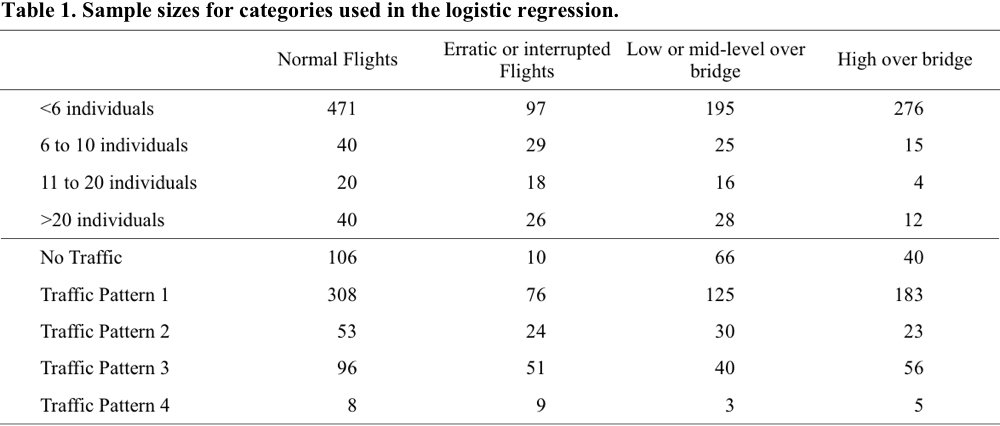
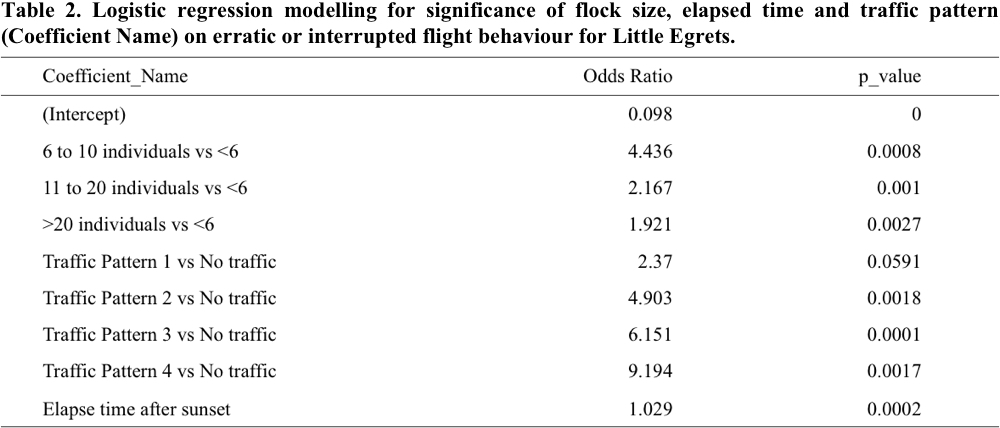
Height of flight
There were 307 flocks of Little Egrets flying high over the bridge vs 264 flocks of Little Egrets flying low or mid-level over the bridge (Table 1). Height of flight above the bridge was not associated with flock size (p > 0.05 for all categories; Table 3). However, elapsed time after sunset had a significant positive relationship (p < 0.001) with height of flight, i.e. flights later in the evening were associated with birds flying high over the bridge (Table 3).
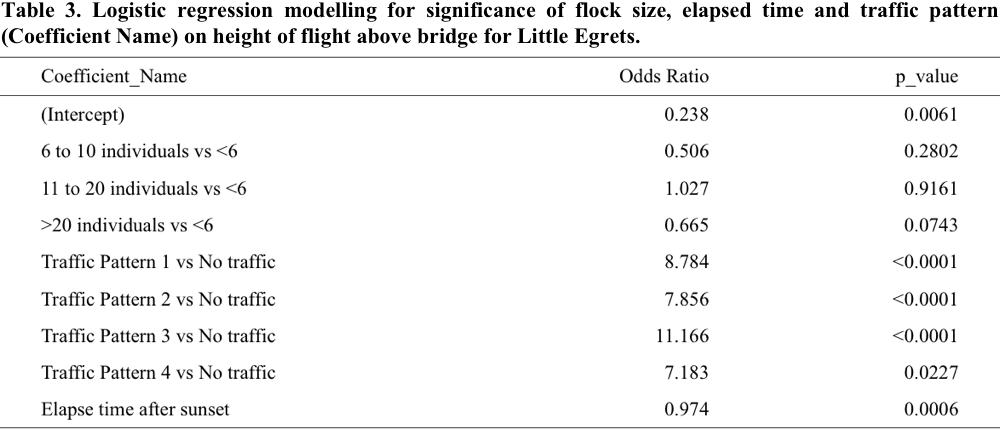
All traffic patterns when compared to no traffic showed higher liklihood of high flights (all p-values < 0.05). The odds of high flights was 8.8 times greater when traffic pattern was 1 (i.e. single car on carriageway) as opposed to no traffic on the carriageway (P < 0.0001) (Table 2).
The higher the level of traffic, the more likely it was that egrets would alter or interrupt their flight behaviour across the bridge on the approach. Birds would still proceed to the roost despite the initial interrupted flight.
Discussion
No collisions of egrets (or of any other birds) with traffic were observed during the study, and no bird kills due to collisions with flyovers or bridges have ever been reported in Hong Kong (Arup 2002). Elsewhere, it would appear that direct impacts with bridges may not have a significant impact on bird mortality (Nilsson and Green 2011) and this appears to be the case for this study. This is despite 264 flocks (made up of a total 2,478 individual Little Egrets) passing low or mid-level over the bridge; which corresponds to a height of between 3-12 m above the bridge surface, the lower limits of this being within the range of some of the larger vehciles on the road. These heights are comparable to other studies in Hong Kong, where the mean heights of flying birds above the bridge surface ranged from between 9-12 m (Arup 2002).
This study showed that flocks of egrets nearly always flew over, rather than under, the road bridge that intersected their approach to roost. Given the lack of clearance under the bridge, and that the night roost is still 280 m from the bridge, it is perhaps not surprising that approaching birds are more likely to fly over the bridge. It is suspected that the birds that arrived under the bridge had been foraging locally i.e. where the nullah meets the harbour and, therefore, did not have the momentum, angle or inclination to fly up and over the bridge.
The height of flight above the bridge and tendency to show interupted or erratic flight behaviours were influenced by the level of traffic and time of day. While their flight and approach would be affected by moderate to high levels of traffic in so far as erratic flight behaviour, all birds would still proceed to the roost site, either as a re-grouped flock or in smaller groups at a similar height to which they passed over the bridge. Arup (2002) revealed that all birds reacted to bridges by changing altitude and reacted to vehicles on bridges by changing flight direction or altitude. For the current study, Little Egrets appeared behaviourally adaptable to traffic and to the possibility of collisions with either vehicles or the bridge structure. This may also be aided by the combination of the raised footpath and pedestrian handrail on the outside of the bridge which also causes the birds to fly higher than the road and thus reduce risk of collision with vehicles; it has been suggested elsewhere that well-designed vertical barriers are advantageous in reducing mortality from road traffic (Pons 2000).
Acknowledgements
Thanks to Nemo Zhang and Philip Tang for the organization and processing of the data and to Jenny Hui who helped to produce the map. Also many thanks go to Professor Phil Round whose comments greatly helped improve the original version of this manuscript.
Literature Cited
Anon. 2005. Field trials on pond wiring to reduce cormorant predation in commercial fish ponds 2004-05. Report to Agriculture, Fisheries and Conservation Department, Hong Kong Special Administrative Region Government. Contact: Agriculture, Fisheries and Conservation Department, 5/F, Cheung Sha Wan Government Offices, 303 Cheung Sha Wan Road, Kowloon or mailbox@afcd.gov.hk
Anon. 2009. Study of feeding habitats and foraging flightlines of ardeids colonies in Hong Kong. Report by Hong Kong Birdwatching Society to the Agriculture, Fisheries and Conservation Department, Hong Kong Special Administrative Region Government. Contact: Agriculture, Fisheries and Conservation Department, 5/F, Cheung Sha Wan Government Offices, 303 Cheung Sha Wan Road, Kowloon or mailbox@afcd.gov.hk
Anon. 2016. Summer 2016 Report: egretry counts in Hong Kong with particular reference to the Mai Po Inner Deep Bay Ramsar site. Report by the Hong Kong Bird Watching Society to the Agriculture, Fisheries and Conservation Department, Hong Kong Special Administrative Region Government. [online] Accessed 13 October 2017.
Arup. 2002. Agreement No. CE 39/2001 Shenzhen Western Corridor - Investigation and planning. Environmental impact assessment report to Hong Kong Special Administrative Region. [online] Accessed 13 October 2017.
Arup. 2013. Agreement No. CE 53 / 2008 (CE) Planning and engineering study on development of Lok Ma Chau Loop – investigation. Environmental impact assessment report to Hong Kong Special Administrative Region. [online] Accessed 13 October 2017.
BMT Asia Pacific. 2009. Hong Kong offshore wind farm in Southeastern Waters. Environmental impact assessment report to Hong Kong Special Administrative Region. [online] Accessed 13 October 2017.
Blaker, D. 1969. The behaviour of the Cattle Egret Ardeola ibis. Ostrich, 40: 75-129.
Erickson, W. P., G. D. Johnson and D. P. Young. 2005. A summary and comparison of bird mortality from anthropogenic causes with an emphasis on collisions. USDA Forest Service Gen. Tech. Rep. PSW-GTR-191. 1029-1042. [online] Accessed 13 October 2017.
ERM. 2009. Development of a 100MW offshore wind farm in Hong Kong. Environmental impact assessment report to Hong Kong Special Administrative Region. [online] Accessed 13 October 2017.
Evans Ogden, L. J. 2002. Summary report on the bird friendly building program: effect of light reduction on collision of migratory birds. Fatal light awareness program (FLAP). 5. [online] Accessed 13 October 2017.
Finnis, R. G. 1960. Road casualties among birds. Bird Study 7: 21-32.
Gauthreaux Jr., S. A. and C. G. Belser. 2006. Effects of artificial night lighting on migrating birds. Pp. 67-93 in Ecological Consequences of Artificial Night Lighting. (C. Rich and T. Longcore, eds.). Island Press, Washington, D.C., U.S.A.
Gehring, J, P. Kerlinger and A. Manville. 2009. Communication towers, lights, and birds: successful methods of reducing the frequency of avian collisions. Ecological Applications 19: 505-514.
Jacobson, S. L. 2005. Mitigation measures for highway-caused impacts to birds. USDA Forest Service Gen. Tech. Rep. PSW-GTR-191. [online] Accessed 13 October 2017.
Kwok, H. K. and T. D. Dahmer. 2002. Habitat utilization by Little Egrets Egretta garzetta breeding at Tai O egretry. Memoirs of the Hong Kong Natural History Society 25: 95-104.
Martin, G. R. 2011. Understanding bird collisions with man-made objects: a sensory ecology approach. Ibis 153: 239-254.
Nilsson, L and M. Green. 2011. Birds in southern Öresund in relation to the wind farm at Lillgrund. Final report of the monitoring program 2001-2011 Biologiska institutionen, Report to Öresundskonsortiet. Ecological Institute, University of Lund. [online] Accessed 13 October 2017.
Owens, L. K. and R. W. James. 1991. Mitigation of traffic mortality of endangered Brown Pelicans on coastal bridges. Transportation Research Record 1312: 3-12.
Parsons Brinckerhoff. 2011. Kosciuszko Bridge project. Reevaluation statement to U.S. Department of Transport. [online] Accessed 13 October 2017.
Podolsky, R., D. G. Ainley, G. Spencer, L. Deforest and N. Nur. 1998. Mortality of Newell’s Shearwaters caused by collisions with urban structures on Kaua’i. Colonial Waterbirds 21: 20-34.
Pons, P. 2000. Height of the road embankment affects probability of traffic collision by birds. Bird Study 47: 122-125.
Stanton, D. J. 2011. Observations at the Wong Chuk Hang ardeid night roost in 2009. Pp. 360-373 in Hong Kong Bird Report 2007-08 (G. Carey, J. Allcock, G. Chow and G. Welch, eds.). The Hong Kong Birdwatching Society, Hong Kong.
Transport Department. 2010. The annual traffic census 2009. Traffic and Transport Survey Division Publication No. 10CAB1. [online] Accessed 13 October 2017.
Voisin, C. 1991. The herons of Europe. T & AD Poyser, London, U.K.
Weston, F. M. 1966. Bird casualties on the Pensacola Bay Bridge (1938-1949). Florida Naturalist 39: 53-54.
Wong, L. C., R. T. Corlett, L. Young and J. S. Y. Lee. 1999. Foraging flights of nestling egrets and herons at a Hong Kong egretry, South China. Waterbirds 22: 424-434.
Wong, L. C., R. T. Corlett, L. Young and J. S. Y. Lee. 2001. Utilization of wetlands by ardeids in Starling Inlet, Hong Kong: a year-round study and a comparison between the census and flight-line methods. Waterbirds 24: 153-160.



